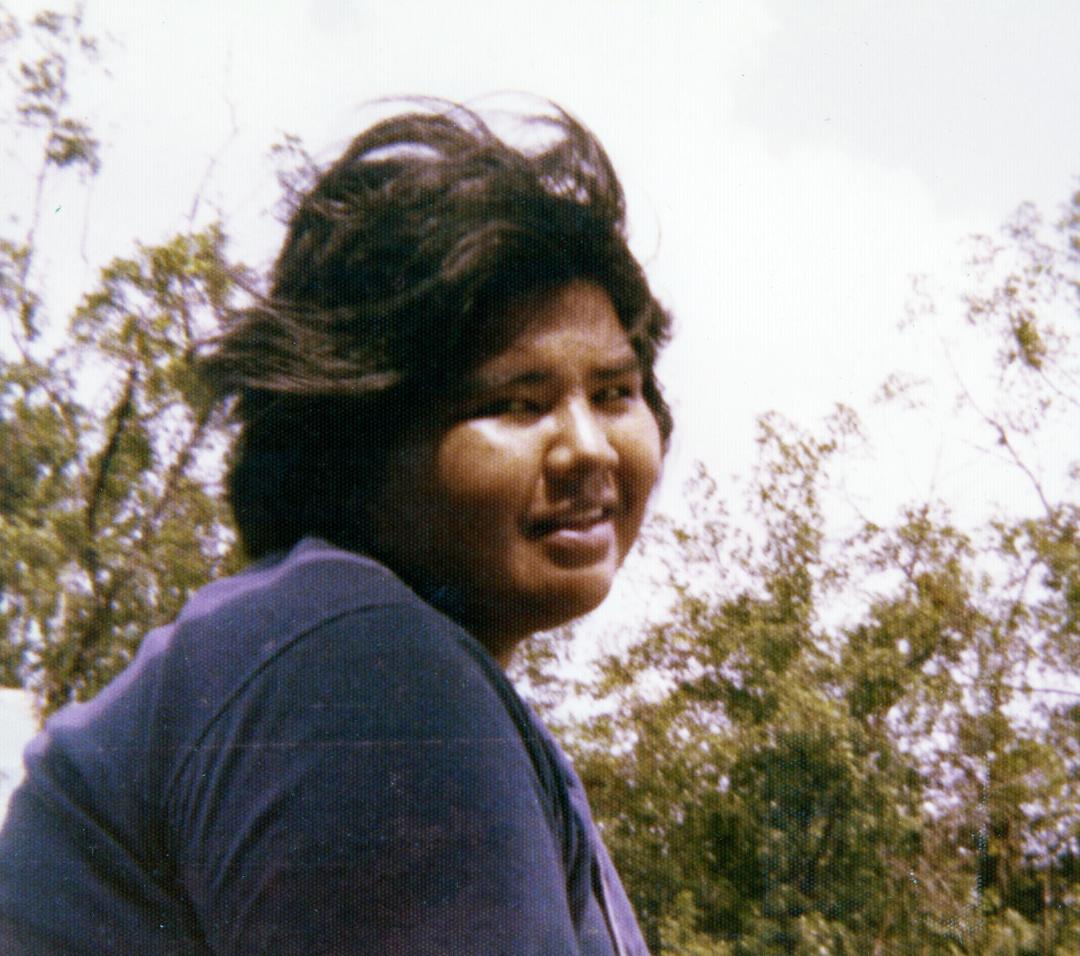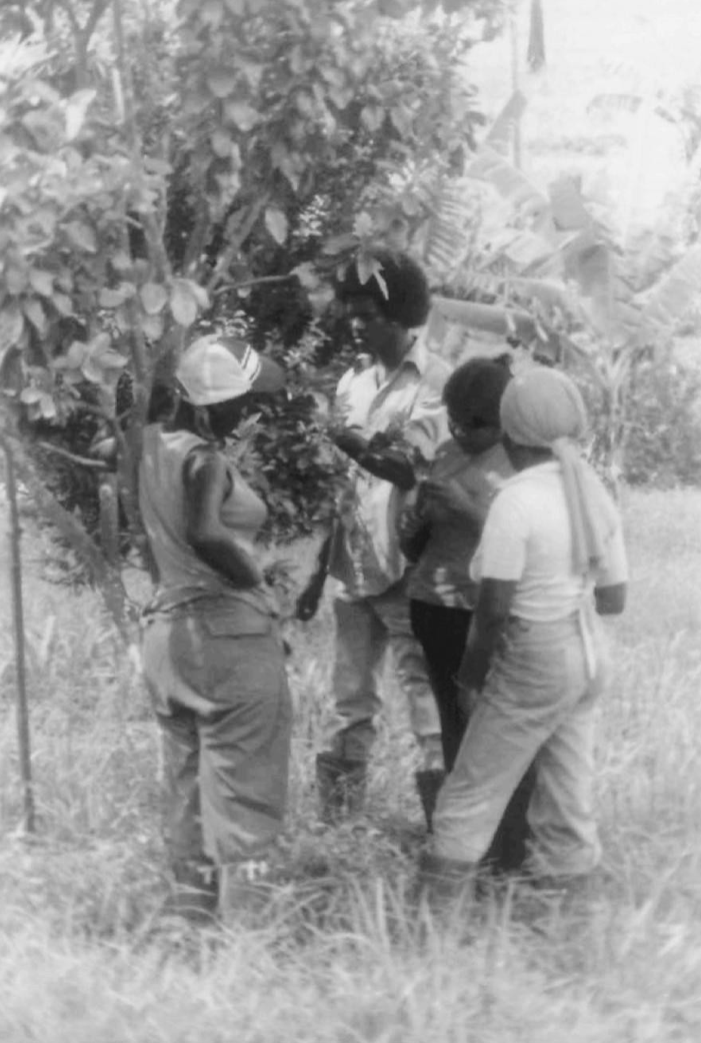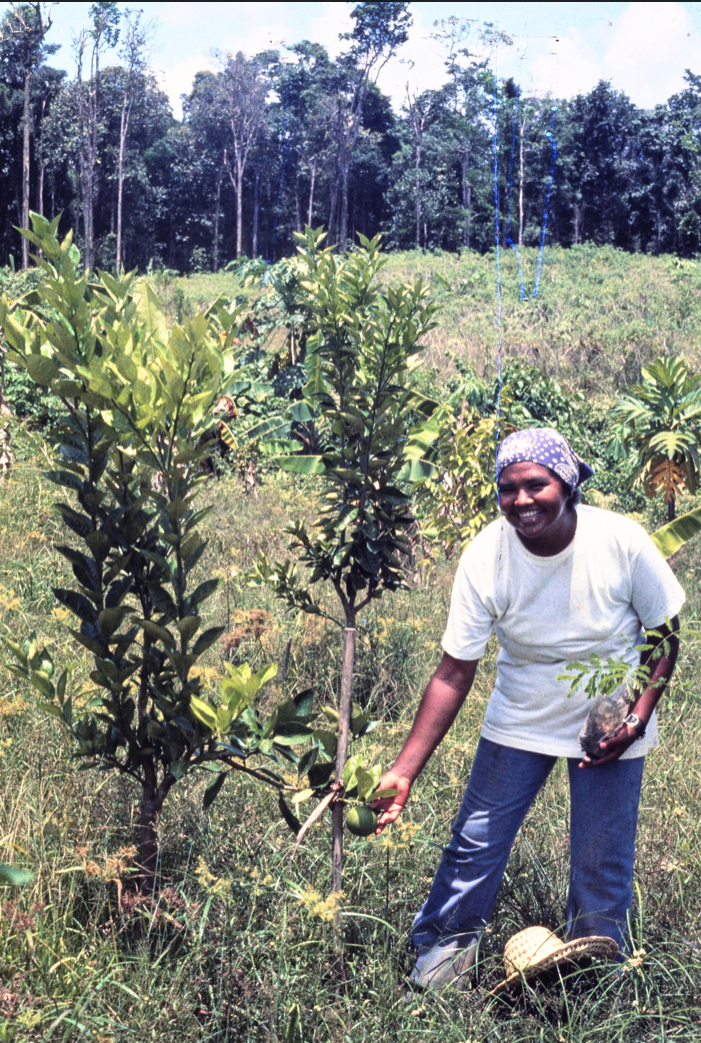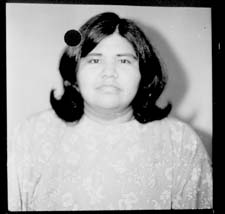 Janice Louise Wilsey joined Peoples Temple when she was still a teenager. She was the second of three children born to Franklin (“Hank”) and Barbara Wilsey, from Covelo and Ukiah; she had an elder brother, Sam, and a younger one named Douglas. Jan attended Ukiah High School, during the time that Jim Jones taught grade 6 in Potter Valley. However, it is unclear whether it was there that she had first met him, or rather in one of his night classes in the Ukiah adult education program: Jan’s friend Christine Lucientes was a regular attendant of the latter ones and might have taken her there. [1] The lively atmosphere Jones created, and his personal engagement with each and every one of his students attracted young people. For Jan and Christine, however, the attraction of Peoples Temple and its pastor went far beyond. They seemed to have found something truly life-changing and meaningful.
Janice Louise Wilsey joined Peoples Temple when she was still a teenager. She was the second of three children born to Franklin (“Hank”) and Barbara Wilsey, from Covelo and Ukiah; she had an elder brother, Sam, and a younger one named Douglas. Jan attended Ukiah High School, during the time that Jim Jones taught grade 6 in Potter Valley. However, it is unclear whether it was there that she had first met him, or rather in one of his night classes in the Ukiah adult education program: Jan’s friend Christine Lucientes was a regular attendant of the latter ones and might have taken her there. [1] The lively atmosphere Jones created, and his personal engagement with each and every one of his students attracted young people. For Jan and Christine, however, the attraction of Peoples Temple and its pastor went far beyond. They seemed to have found something truly life-changing and meaningful.
In a 1972 documentary (People’s Temple, by David Gottlieb and Jim Ruxin), Jan tells the story of her first personal encounter with Jim Jones. Visibly moved by the reminiscence of it, she recounts how overwhelmed she had been by the undivided attention he had given to her back then, by his readiness to put everything else behind in order to talk and listen to her, and to help her with whatever trouble she might have. As Jan talks, her face is lit up by a shy, radiant smile; she is sitting right in the center of a group of young Temple members and seems to feel happy and at ease.
Only small bits of information could be found about Jan’s early years in the church:
The first one is from Kathy Barbour, a former member, who fondly remembers a Temple service in Redwood Valley when Jan was given an opportunity to shine. She writes :
During the service, Jan Wilsey, a young Native American from the Pomo tribe in Middletown, stood up and sang Buffy Sainte-Marie’s “My County Tis of Thy People You’re Dying,” a wrenching recount of the tragedies suffered by her people. Well, I had loved that song, and Buffy Sainte-Marie, and it just swept me away.
Another document provides information on the kind of work Jan was doing in the church. In 1973, eight young people – known as the Eight Revolutionaries – left the community. In a letter to Jim Jones explaining their reasons for their departure, they wrote that the “equality” Jones preached did not really exist, that there was no justice when it came to assigning jobs within the Temple. They noted that the leadership was almost exclusively white, while the vast majority of the membership was not. They used Jan, whom they considered a good worker who deserved better than what she got, as an example to drive home their point:
Jan Wilsey and Christine Lucientes came to People’s Temple at the same time. Christine is put on staff […]. Jan is at the doors every meeting doing her job. Christine flunks out of school, gives the church a bad name at SRJC [Santa Rosa Junior College] Nursing School, however, she’s white and makes staff.
If Jan felt the same way, or if she was perfectly happy to do her job at the doors while her friend was given other, more prestigious tasks, may never be known.
In any case, her work situation would soon change. The plan to build up a settlement in Guyana became more and more a focus in Jones’ addresses to his congregation; in a sermon delivered in San Francisco in November 1974, he laughs that it would be great if also some Native Americans would go to the so-called “Promised Land” as builders, then adds:
And I don’t have that many Indians to send there, I’m gonna send one. Jan’s going on the next boat to the Promised Land. (Q 1058-2)
The crowd cheers and applauds. And that’s how Jan got there.
Jonestown

In Jonestown, as one of the few early settlers who built the place, Jan Wilsey soon assumed several responsibilities which had eluded her in the States. In the beginning, she lived there with only a handful of other people. From what the few survivors say, life in Guyana was good in those early years: they worked hard, they were supported by the Amerindian people who lived in the neighboring villages, and there was friendship and a good and positive spirit among them. Jan apparently loved the land, and later on, she’d become one of Jonestown’s experts in agriculture. She studied how to grow plants and fruit, and how to work the land. She became the leader of a crew – and later of several crews – that worked in the fields. “Jan’s crew” received a lot of praise in the Agricultural meetings and People’s Rallies of 1977 and 1978. The notes from a December 1977 meeting reported that, “Jan’s crew worked overtime kept good attitude,” and that “Jan’s crew [was] very productive today working on pineapples.”
Jan was one of those who knew what had to be done, how many people would be needed to do it, how to organize field work. She became an expert, an organizer, and a planner. And people – including Jim Jones – listened to her. Here are some examples:
Jan’s rice fields
Rice was essential in nourishing the people of Jonestown, and was part of most meals. To grow it on their own land would have given anyone a lot of satisfaction. It certainly did for Jan.
In March 1978, Edith Roller wrote in her diary that
Jan Wilsey says rice grows best on bush soil which has just been cleared. One variety is doing well in spite of having no rain. It is ready to harvest. She wants land to plant three different varieties experimentally.
And she got what she wanted. Two months later, in May 1978, Jan reported: “Four more acres of rice planted. One planted broadcast didn’t come out well.” In a second entry written a week later, Roller quotes Jan as saying, “Rice doing well on burnt field. Haven’t had to use commercial fertilizer.” When birds came from the jungle and invaded her rice fields in August, Jan found a way to scare them off. As Edith intimated in her March 1978 journal, Jan undoubtedly took great pride when she reported: “First time harvested our own rice; first time planted our own rice.”
But rice alone wouldn’t do it. In that same month, Edith noted that:
Jim says he wants a crop that will be self-sufficient, feed a thousand people. Jan thinks sweet cassava can do it, with improvement by spraying before it is brought in. Eddoes and cassava together.
Jones asked her to have her projections ready next week. She was clearly a person whose expertise was valuable for the community.

Challenges
The challenges she faced in working the land were numerous. In May 1978, Jan lamented over “8 acres trouble with larvae.” She announced at one point that she would be going up the river to get new stock, and at another that she was already going to get coffee trees. This meant her work allowed her to travel around a bit and to get in touch with people in the villages around.
Watering the fields was another problem. On one occasion, she inquired “about getting tank ready for watering fields now being watered by hand,” and then provided her own answer: “crane being used to unload crates but can do job next week.”
She also cares for the well-being of her community: “Jan Wilsey [says] children are picking up cutlass beans over the cottage area and fields,” Edith wrote in April 1978. “[The children] Should be warned they must not be eaten raw.”
And she spoke her mind: Once, a good number of the papaya transplants died. It was a serious loss, and apparently happened due to the negligence of Gene Chaikin. Better known as one of the Temple’s lawyers, Chaikin also worked in the agricultural team. The discussion revealed that Chaikin hadn’t consulted the other agricultural experts when problems arose, but rather just proceeded as he thought was best. Jan was the one to tell him that he was too sure of himself. The group decided that in the future, Chaikin would give more consideration to others’ opinions, and would be more cautious that a job was done properly. The community would grow more papaya, and once again, it was Jan who had the last word on the issue: “Jan suggests shade papayas we now have and mulch others.”
When she had an idea she thought would be good, she was persistent in her demands. As Edith Roller reports in her entries from March 1978 Jan Wilsey “wants Patty [Cartmell] and others to look for pineapple suckers.” Other people objected to this plan, so she dropped the matter… but only for the moment. Within two weeks, she was back: “Jan wants pineapple suckers procured by Patty and Rheaviana [Beam] and by Georgetown.” It wasn’t long until she got her way: by the end of the month, Roller records that “Jim … wants to plant ten more fields of pineapples with sucker.”
Community
Jan knew how to stay out of trouble. Jonestown’s Peoples Rallies included confrontations with individuals whenever they did something wrong, usually with harsh criticism and punishment. Jan does not appear in the record as one who received a reprimand, nor was she one of the persons who attacked others. Instead, she hardly ever spoke in those rallies; her mind seemed to be with the land, and her work, with the beauty of it, and not with the community’s petty problems.
Being a hard worker herself, however, she did seem to be critical about people who were not – but her remarks were never very harsh. In May 1978, Roller wrote: “Keith Wade reported walking around and not working. Jan Wilsey says he has this habit.” On another occasion, when Jones and the community attack Laura Johnston for some unrevealed wrongdoing and – worse – for lack of production, Jan offered what was by far the most friendly remark in the whole discussion: “Jan says she’s aware of Laura’s lack of produce, thought she’d improve.”
More often, Jan was among those who praised people: she made it known when someone in her crew had done an especially good job, so that they got the recognition they deserved.
She was also an effective supervisor, to the point that things didn’t go as well when she was absent. In a tape from early April 1978, Jones complained that “the field crews have not been doing their job since Jan Wilsey and others left for Georgetown.”
* * * * *

Visitors who came to Jonestown before the tragedy were always very impressed by the beautiful fields and gardens. It seems that much of this beauty was due to the work of Jan Wilsey. It is sad to think about the plans she undoubtedly still had for this beautiful land.
What other hopes and dreams she might have had for the future that was taken from her can only be imagined. Written personal statements from Jonestown are rare, and of those that exist, most cannot be trusted. This is especially true for the following document which is from a time when the cultivating of paradise had no longer been a matter of priority. Instead, there was an atmosphere of growing exhaustion, anxiety, and hopelessness, triggered by real and imagined threats against the community, by Jones’ growing paranoia, and by his rhetoric of war, doom and death. Peoples’ dedication to “the cause” – which had always been of utmost importance – was now claimed to an extent that they were asked to provide written statements on how they would give their lives for it (the statements were collected by Rita Tupper in the Responses to What One Would do With Their Body ). The answers are, with a few exceptions, much alike, providing probably what was felt to be expected: elaborations on different ways to kill “enemies” and on everyone’s readiness to die. Jan spins the same gory story – nevertheless, the frames in which she embeds it are worth a look.
She writes:
I am ready at this time or any time to go back to the States. If I was stopped at the airport and asked why I was coming back, I would say I came back because that is what I wanted to do. I would tell them I liked the idea of going to a new land and meeting people, but I did not like the idea of leaving my family back here. They could have come to Guyana, but their roots are here, and so this is where I will live the rest of my life.
In what follows, she specifies the ways she’d be willing to kill and die. And, not very consistently, but probably much more from her heart, she closes by saying:
I would like to adopt a baby so I will look more to the future if we are going on for a time.
* * * * *
Janice Louise Wilsey would not live to see a baby grow up, and she would not see the land again where her parents had their roots. She was 29 when she died in Jonestown. Her remains were brought home by her family and buried in Headquarters Cemetery, one of three Indian burial grounds in Round Valley. For anyone who lives nearby and would like to visit, here is how you can find the place:
[F]rom Highway 101, take the Highway 162 cutoff to Covelo. The turnoff is 12 miles north of Willits. Twenty-three and a half miles up highway 162 is the Round Valley Historical marker. Take a minute to stop and read it and view Round Valley. Headquarters Cemetery is one mile north of Covelo at Biggar Lane. The entrance is on highway 162, just past Biggar Ln., on the left.[2]
May you rest in peace, Janice Louise Wilsey, and may you be remembered for the love you gave, and for the beauty you tried to create.
(Heidi König-Porstner’s previous article for this site is Jim Jones’ news broadcasts in 1978: Red Army Faction & the two Germanys (2018). She has also translated several resources from this website into German at Alternative Considerations – Texte auf Deutsch (2019). She is an author and award-winning translator of poetry, who lives in Vienna, Austria. She can be reached at adelheidanna@gmx.at.)
Notes
[1] Jeff Guinn, The Road to Jonestown, e-book, pos. 2282.
[2] http://files.usgwarchives.net/ca/mendocino/cemeteries/headquarters.txt